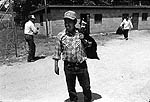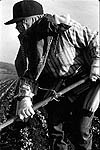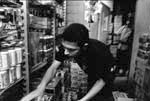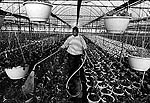
|
The New Americans |
|

|
In the U.S., the Indians from Cherán are, by and large, inhabiting
not some marginalized space on the other side of the tracks, not
some new Mexican shantytown segregated from the larger society
but living alongside the "natives": poor blacks, whites and Asians.
They are being transformed by the experience and are likewise
transforming towns across the heartland.
|

|
A couple more "postcards" from the places we've been:
Norwalk, Wisconsin: a town of five hundred, half of whom are employed
at the local meat-packing plant, most of these Mexicans, many
from Cherán. The migrant boys have taken a liking to the local
white girls "the daughters of Mennonites, Amish, Plain Christians"
and vice-versa. The lovers speak only broken English and broken
Spanish. But the law of desire speaks its own language and we're
always going to desire the Other: there are a few dozen babies
in town now, sandy-haired, green-eyed, golden-skinned, a new Cosmic
race. The Indians hold traditional dances on Main Street. The
white girls blast norteña music from their car stereos, the Mexican
boys walk around with heavy metal buzzing in their Walkman headphones.
But not all is peaceful here; down at the bar "there are only
two bars in Norwalk, and one restaurant" the brown boys and white
boys (usually over jealousy and sometimes over issues of employment)
shoot 'em up like the Old West. Norwalk hasn't had this much action
since the Indian Wars.  |
|

|
Dallas, Texas: just south of Dealey Plaza, the ghetto: at an intersection
in the shadow of an I-35 overpass, a liquor store for poor whites,
poor blacks, and poor Mexicans. The Mexicans work the store, serve
the whites and blacks. A white dude straight out of the pen tells
us he hates the niggers. The Mexicans say they're discriminated
against by the whites. A couple of black hip-hop teens tell us
that there's no problem between Mexicans and blacks, but that
both do have a problem, however, with the whites. In cities across
America, in liquor store parking lots, along the industrial boulevards,
within walking distance of the gleaming redevelopment towers downtown,
there is this new, mulltihued dynamic occurring, that is two parts
class and one part race. It is the ground zero of urban conflict
for the new century, and it is far more complex than the black-white
paradigm that our media and politicos still profer as our racial
truth.  |

|
Benson, North Carolina: a Mexican grocery store that sells tortillas
and chiles and rents Mexican B-movies to the tobacco pickers,
who, on average of about once a week, come down from their work
camps "whose conditions are reminiscent of FSA photographs" and
stock up on goods. At a MacDonald's a few blocks away, they are
giving away Los Tres Caballeros dolls to Mexican and gringo customers
alike. Captain Roger Crouch of the Benson PD says, "Well, them
Meskins ahhrr ah-write. Once in a why-al they'll be gettin' drunk
as a skunk and weeel haul 'em in, ya know. Now, I don't speak
no Meskin, and them boys sure as hell don't speak no American..."
A bewildering thing, this Mexican presence in the South.
|
|
|
|